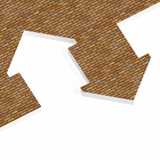The average price of terraced homes in the UK has risen by more than any other type of property over the last 10 years, according to new Halifax research. Owners of terraced properties have seen the value of their property rise by an average of £118 a week over the past decade with the typical […]
 The average price of terraced homes in the UK has risen by more than any other type of property over the last 10 years, according to new Halifax research.
The average price of terraced homes in the UK has risen by more than any other type of property over the last 10 years, according to new Halifax research.
Owners of terraced properties have seen the value of their property rise by an average of £118 a week over the past decade with the typical price of a terraced home increasing by 68 per cent (£61,489) from £89,843 in 2001 Quarter 2 to £151,332 in 2011 Quarter 2.
Over the past 10 years, the price of the average UK home has risen by 53 per cent from £116,325 in 2001 Quarter 2 to £177,740 in 2011 Quarter 2. Bungalows recorded the second biggest increase (68 per cent), followed by semi-detached properties (62 per cent).
Despite terraced properties recording the strongest price growth over the past decade, they remain the most affordable property type. The price of an average terraced property is 15 per cent below the average UK house price of £177,740 and 45 per cent lower than the price of the average detached home of £273,173. In 2001, the typical terraced house price was 23 per cent lower than the UK average house price for all properties.
Terraced homes also saw their share of all house sales rise by more than any other property type over the past decade, increasing from 31 per cent in 2001 to 34 per cent in 2011. In contrast, detached homes were the only property type to see a drop in their share of all sales since 2001, declining from 21 per cent to 14 per cent. This decline was driven by a large drop in the proportion of home movers buying detached homes (from 30 per cent to 22 per cent).
Semi-detached and terraced homes have remained the most popular types of property purchased over the last 10 years. These property types represent nearly two-thirds (63 per cent) of all home sales in 2011; up from 59 per cent in 2001. For first-time buyers, semi-detached homes have risen in popularity, accounting for 29 per cent of purchases in 2011 compared with 26 per cent in 2001.
Flats recorded the smallest price growth over the decade to 2011 with the value of a typical flat rising by 49 per cent. This relative underperformance largely reflected an over-supply of this type of property in some parts of the country. Flats more than doubled during the 2000s, as a proportion of all dwellings built in England, rising from 20 per cent in 2000/2001 to a peak of 50 per cent in 2008/09. This proportion has since dropped to 35 per cent in 2010/11 during the marked downturn in the housing market.
Terraced homes account for the biggest price growth in most UK regions
Terraced properties recorded the largest price increases of any property type in eight of the eleven UK regions tracked1 over the last 10 years. In contrast, detached properties and flats witnessed the smallest percentage gains over the period across nine regions.
Yorkshire and Humber and Scotland accounted for the biggest price rises across all five property types since 2001, while London accounted for the smallest gains across all property types.
Suren Thiru, Halifax housing economist, said:
“Although all property types have recorded significant price increases overall during the past decade, terraced homes have seen the biggest growth. Demand for such properties is likely to have been supported by their relatively favourable levels of affordability over the period. The rapid house price rises during much of the 2000s priced many potential home movers out of the upper end of the UK housing market.”













